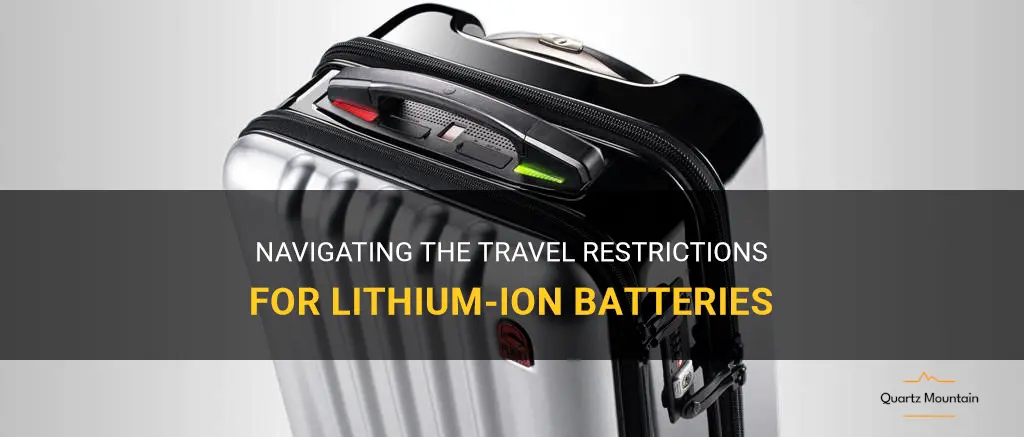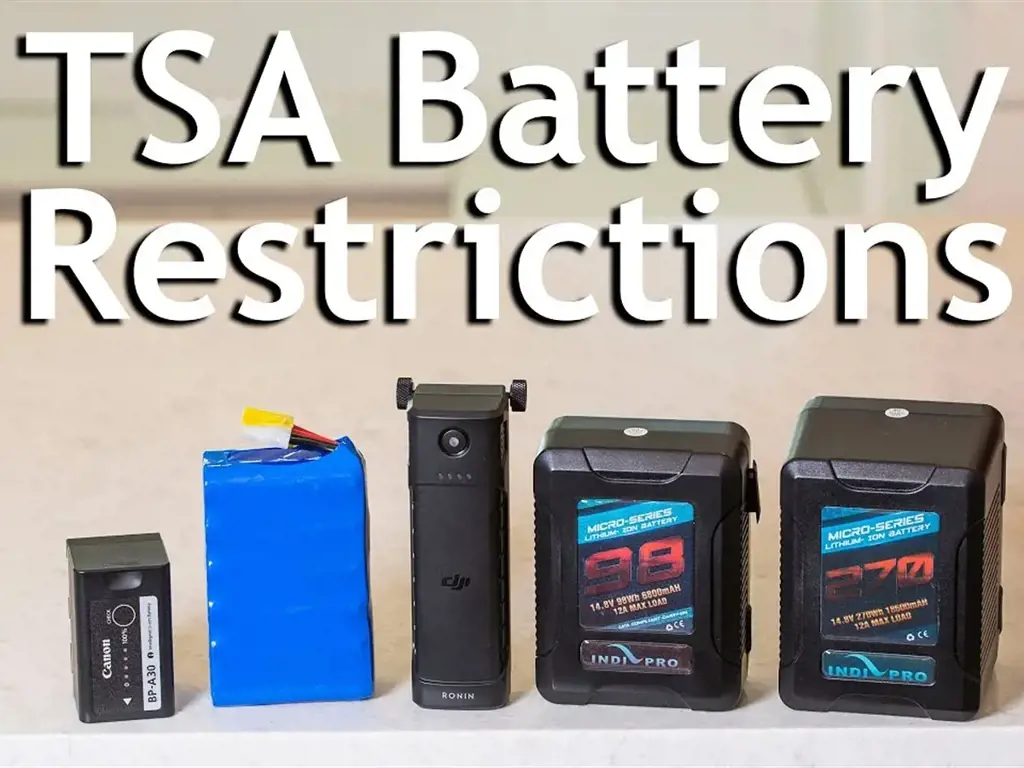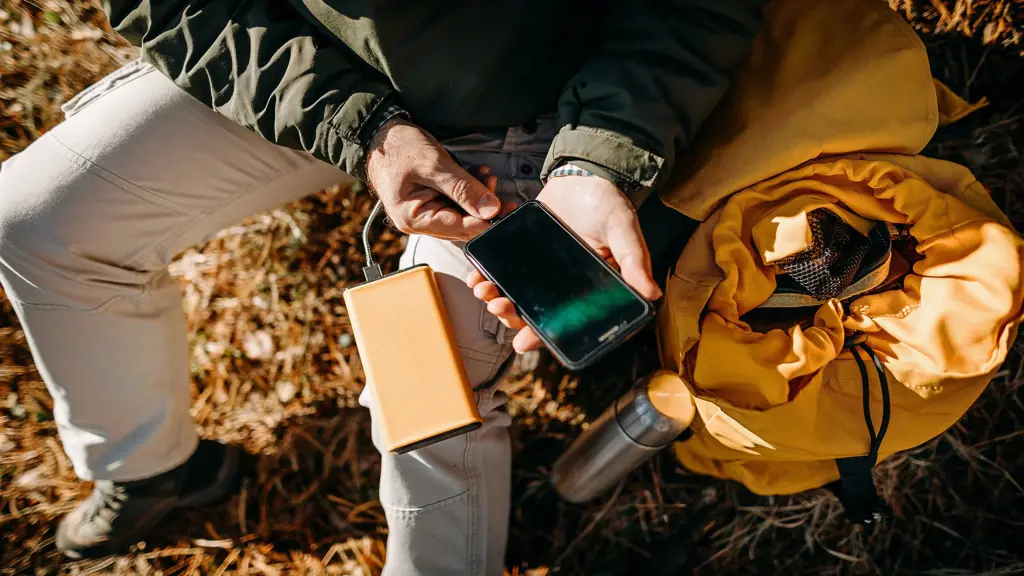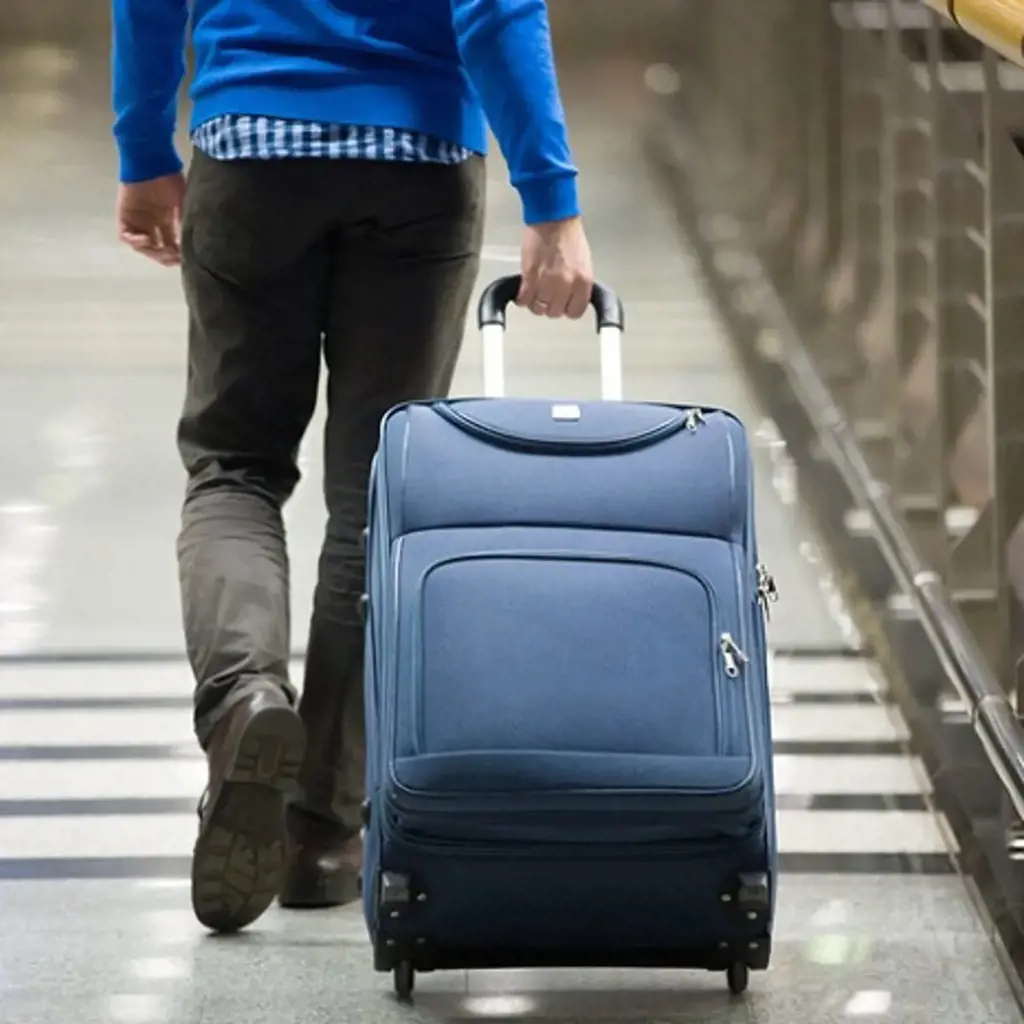
Lithium-ion batteries have become widely popular and integral to our daily lives, powering our smartphones, laptops, and electric vehicles. However, due to their high energy density, there are important travel restrictions and safety precautions when it comes to carrying these batteries. Understanding these restrictions is crucial for anyone planning to travel with lithium-ion batteries to ensure safety and compliance with regulations. In this article, we will explore the intricacies of lithium-ion battery travel restrictions and delve into why they are in place.
What You'll Learn
- What are the major restrictions or regulations for traveling with lithium ion batteries?
- How do airlines enforce lithium ion battery travel restrictions?
- Are there any specific requirements for carrying spare lithium ion batteries in carry-on vs. checked baggage?
- What are the safety concerns associated with lithium ion battery travel?
- Are there any exceptions or special considerations for traveling with lithium ion batteries for medical devices?

What are the major restrictions or regulations for traveling with lithium ion batteries?

Lithium-ion batteries are a popular power source for electronic devices due to their high energy density and long life. However, when it comes to traveling with lithium-ion batteries, certain restrictions and regulations need to be followed. These restrictions are in place to ensure the safety of passengers and crew members on board aircraft, as lithium-ion batteries have been known to pose a fire risk.
One of the major restrictions for traveling with lithium-ion batteries is the quantity allowed. Passengers are generally allowed to bring lithium-ion batteries for personal use in their carry-on baggage, but there are limits on the number of batteries and their watt-hour rating. The exact limits may vary depending on the airline and the country you are traveling to, so it is important to check with the airline before your trip.
In general, lithium-ion batteries with up to 100 watt-hours are allowed in carry-on baggage with no restrictions. This includes most common consumer electronics such as cell phones, laptops, tablets, and power banks. However, spare batteries with a watt-hour rating between 100 and 160 are generally allowed in carry-on baggage with the airline's approval. Any lithium-ion batteries with a watt-hour rating above 160 are not allowed in carry-on baggage and must be shipped separately as cargo.
Another important regulation is the way the lithium-ion batteries are packed. All lithium-ion batteries must be individually protected to prevent short circuits and ensure they do not come into contact with metal objects. This can be done by placing each battery in its own plastic bag or packaging it in a way that prevents contact with other batteries or metal objects. Additionally, it is recommended to tape the battery terminals or place them in a protective case to prevent accidental activation.
It is also worth noting that damaged or recalled lithium-ion batteries are not allowed on board any aircraft, regardless of their watt-hour rating. If you have a damaged or recalled battery, it is best to dispose of it properly before traveling.
When it comes to shipping lithium-ion batteries as cargo, there are additional regulations that need to be followed. These regulations are stricter than the ones for carrying batteries in carry-on baggage due to the higher risk associated with shipping large quantities of batteries. Proper labeling, packaging, and documentation are required to ensure the safe transport of lithium-ion batteries.
In conclusion, traveling with lithium-ion batteries comes with certain restrictions and regulations to ensure safety. These restrictions include limitations on the quantity and watt-hour rating of batteries allowed in carry-on baggage, as well as proper packaging and labeling. It is important to check with your airline and follow their guidelines to ensure a hassle-free journey.
Navigating Hidalgo County Travel Restrictions: What You Need to Know
You may want to see also

How do airlines enforce lithium ion battery travel restrictions?

Lithium-ion batteries have become an integral part of our everyday lives, powering numerous devices such as smartphones, tablets, laptops, and even electric vehicles. However, when it comes to air travel, these batteries pose significant safety risks and are subject to strict regulations. Airlines enforce these restrictions to ensure the safety of passengers and crew members and to prevent any potential incidents during flights.
The primary concern with lithium-ion batteries is their potential to catch fire or explode, especially if damaged or mishandled. These batteries contain highly flammable electrolytes and can release harmful gases and heat when damaged or punctured. In the event of a fire or explosion, they can be extremely difficult to extinguish and can cause catastrophic damage to an aircraft.
To address these safety concerns, airlines worldwide follow guidelines set by international organizations such as the International Air Transport Association (IATA) and the International Civil Aviation Organization (ICAO). These guidelines dictate the conditions under which lithium-ion batteries can be carried on board and the necessary precautions to be taken.
Passengers are generally allowed to bring lithium-ion batteries in their carry-on baggage, but restrictions may apply to spare or loose batteries. Typically, spare batteries with a capacity exceeding 100 watt-hours (Wh) are not allowed in carry-on or checked baggage. In contrast, spare batteries with a capacity of less than 100 Wh are allowed in carry-on baggage, but not in checked baggage. This capacity limit applies to both rechargeable and non-rechargeable lithium-ion batteries.
To enforce these restrictions, airlines rely on several measures. Firstly, during the check-in process, passengers are required to declare any lithium-ion batteries they are carrying. Airport security personnel may subject the batteries to visual inspection or use X-ray machines to verify their authenticity and capacity. Any batteries exceeding the allowed capacity may be confiscated or denied boarding.
Additionally, airlines and airport authorities conduct regular inspections of luggage to detect any prohibited items, including lithium-ion batteries. Security personnel are trained to identify batteries and closely examine them for compliance with the regulations. If a passenger is found to be in possession of unauthorized batteries, they may face penalties or be denied boarding.
Furthermore, some airports have implemented specialized equipment to detect potential hazardous substances, including lithium-ion batteries. These devices use techniques such as gas chromatography or mass spectrometry to identify and analyze the chemical composition of items passing through baggage screening. If a battery is detected, it can be flagged for further inspection, ensuring adherence to the regulations.
In conclusion, airlines enforce lithium-ion battery travel restrictions to minimize the risk of fires or explosions during flights. Passengers are required to comply with regulations governing the carrying of lithium-ion batteries, and airlines employ various measures to enforce these restrictions, including visual inspections, X-ray screening, and specialized detection equipment. By adhering to these regulations, airlines aim to ensure the safety of their passengers and crew members and maintain the highest level of aviation security.
Ireland's Prescription Travel Restriction Update: What You Need to Know
You may want to see also

Are there any specific requirements for carrying spare lithium ion batteries in carry-on vs. checked baggage?

When traveling with lithium ion batteries, it is important to be aware of the specific requirements for carrying them in both carry-on and checked baggage. Due to the potential fire hazard associated with these batteries, airlines have implemented certain guidelines to ensure the safety of all passengers.
Carrying spare lithium ion batteries in carry-on baggage is generally allowed by most airlines. However, there are a few key requirements that need to be followed. The batteries should be removed from any devices and placed individually in their original packaging or in protective cases. This helps to prevent any accidental short-circuiting or contact with other metal objects that could potentially cause a fire. It is also recommended to tape the battery contacts or place each battery in a separate plastic bag to avoid any contact with metallic items.
Furthermore, there are specific limits on the size and power rating of lithium ion batteries that can be carried in carry-on baggage. The International Civil Aviation Organization (ICAO) and the International Air Transport Association (IATA) have set a limit of 160-watt hours per battery for portable electronic devices. This means that most commonly used lithium ion batteries, such as those found in smartphones, tablets, and laptops, are well within the allowed limits. However, larger batteries used in certain professional equipment may exceed these limits and may not be allowed in carry-on baggage.
When it comes to carrying spare lithium ion batteries in checked baggage, the rules are a bit stricter. Many airlines prohibit passengers from packing spare lithium ion batteries in their checked baggage due to safety concerns. This is because if a fire were to occur in the cargo hold, it would be more difficult to detect and extinguish. Additionally, the risk of a fire spreading and causing damage to other baggage and the aircraft is higher in the cargo hold.
If you do need to transport spare lithium ion batteries in your checked baggage, it is important to check with your airline beforehand. Some airlines may allow it, but they may have specific requirements such as placing the batteries in a fire-resistant bag or case. It is always recommended to contact the airline directly to inquire about their specific rules and regulations regarding carrying spare batteries in checked baggage.
In conclusion, when traveling with spare lithium ion batteries, it is generally allowed to carry them in carry-on baggage as long as the proper safety precautions are followed. However, it is best to avoid packing them in checked baggage unless absolutely necessary, as many airlines prohibit this due to safety concerns. Always check with your airline beforehand to ensure that you are in compliance with their rules and regulations regarding lithium ion batteries.
Scotland Updates International Travel Restrictions in Response to COVID-19
You may want to see also

What are the safety concerns associated with lithium ion battery travel?

Lithium-ion batteries have revolutionized the way we use portable electronic devices, such as smartphones, laptops, and electric vehicles. They provide high energy density and a long lifespan, making them the preferred choice for many applications. However, there are safety concerns associated with the transportation of lithium-ion batteries, especially when these batteries are not handled properly.
One of the main safety concerns with lithium-ion battery travel is the risk of fire or explosion. Lithium-ion batteries contain flammable electrolytes, and if they are damaged or mishandled during transportation, they can short-circuit and overheat, leading to thermal runaway. This can result in a fire or explosion, particularly if the battery is exposed to high temperatures or if it is packed tightly with other electronic devices.
To mitigate this risk, it is important to follow specific regulations and guidelines for the transport of lithium-ion batteries. These regulations typically include restrictions on the maximum capacity and number of batteries that can be transported in a single package, as well as requirements for packaging and labeling. For example, batteries must be protected from physical damage that could cause a short circuit, and they must be packed in a way that prevents movement or shifting during transportation.
Another safety concern with lithium-ion battery travel is the potential for thermal runaway during charging. Lithium-ion batteries can generate heat during the charging process, and if they are charged too quickly or if they are exposed to high temperatures, this heat can build up and cause the battery to fail. To prevent this, it is important to use chargers that are specifically designed for lithium-ion batteries and to avoid charging the battery in extreme temperatures.
When travelling with devices that contain lithium-ion batteries, it is also important to be aware of the potential for damage or puncture. If a battery is damaged or punctured, it can release flammable electrolytes and gases, increasing the risk of fire or explosion. To minimize this risk, it is recommended to protect devices with lithium-ion batteries by using a padded case or keeping them separate from other objects that could cause damage.
In conclusion, while lithium-ion batteries offer many benefits, there are safety concerns associated with their travel. It is important to follow specific regulations and guidelines for the transport of lithium-ion batteries, to use appropriate chargers, and to protect devices from damage or puncture. By taking these precautions, the risk of fire or explosion during lithium-ion battery travel can be significantly reduced.
Exploring the Latest Kenya-Dubai Travel Restrictions: What You Need to Know
You may want to see also

Are there any exceptions or special considerations for traveling with lithium ion batteries for medical devices?

Traveling with medical devices that require lithium-ion batteries can sometimes present additional challenges and considerations. While lithium-ion batteries are generally safe to travel with, there are a few exceptions and special considerations that should be kept in mind to ensure a smooth and hassle-free journey.
First and foremost, it is important to check with the airline you'll be traveling with about their specific policies and regulations regarding lithium-ion batteries. Different airlines may have different rules in place, so it's crucial to familiarize yourself with their guidelines to avoid any complications or surprises.
In most cases, lithium-ion batteries used in medical devices are allowed to be carried in both checked baggage and carry-on luggage. However, it is highly recommended to carry them in your carry-on baggage for easy accessibility and to prevent potential damage that could occur in the cargo hold.
It is also essential to properly package and protect your lithium-ion batteries to prevent any accidents or damage during transit. The batteries should be installed in the medical device or securely placed inside a protective case or packaging specifically designed for lithium-ion batteries.
You should also ensure that your medical device is easily accessible and can be switched off or put into airplane mode if necessary. This is important to comply with the airline's regulations and to prevent any interference with the aircraft's systems.
Another crucial consideration is the capacity of the lithium-ion battery. In general, lithium-ion batteries with a capacity of less than 100 watt-hours (Wh) are allowed on board without any special requirements. However, if the battery has a capacity between 100Wh and 160Wh, you may need to obtain special approval from the airline or provide additional documentation to prove that the battery is for a medical device.
If your medical device requires a lithium-ion battery with a capacity higher than 160Wh, it is considered a high-capacity battery and may have more stringent restrictions. It's important to contact the airline well in advance to inquire about their specific requirements and whether any special approvals or permits are needed.
Lastly, it's always a good idea to carry documentation that verifies the necessity of your medical device and its lithium-ion battery. This can include a letter from your healthcare provider, prescriptions, or any other relevant documentation that explains the need for the device during your travel.
In summary, traveling with lithium-ion batteries for medical devices requires some additional considerations and preparations. Checking the airline's specific policies, properly packaging the batteries, ensuring easy accessibility to the device, considering the battery capacity, and carrying necessary documentation are all essential steps to ensure a smooth and hassle-free travel experience. By being well-prepared and following the guidelines, you can travel confidently with your medical device and its lithium-ion battery.
The Implications and Challenges of Restricted Air Travel
You may want to see also
Frequently asked questions
Yes, you can bring lithium ion batteries on a plane, but there are some restrictions. Lithium ion batteries must be in your carry-on luggage and not in your checked baggage. This is because there is a risk of the batteries overheating and potentially causing a fire, which can be more easily controlled and extinguished in the cabin rather than the cargo hold.
The number of lithium ion batteries you can bring depends on their capacity. If the batteries have a capacity of less than 100 watt-hours, you can bring as many as you like. If the batteries have a capacity between 100 and 160 watt-hours, you are limited to bringing two batteries. Anything above 160 watt-hours is generally not permitted and requires special approval from the airline.
Yes, you are allowed to bring spare lithium ion batteries with you on a plane. However, these spare batteries must also be in your carry-on luggage and cannot be packed in your checked baggage. It is important to ensure that the spare batteries are properly protected to prevent accidental activation or short-circuiting.
When traveling with lithium ion batteries, it is important to take certain precautions to ensure safety. Keep the batteries in their original packaging or use a battery case that is designed to prevent accidental contact with other metal objects. Avoid exposing the batteries to extreme temperatures and avoid overcharging them. It is also recommended to tape the battery terminals to prevent accidental short-circuiting.
Yes, there are restrictions on flying with damaged or recalled lithium ion batteries. Airlines generally do not allow passengers to bring damaged or recalled batteries on board due to the increased risk of fire or explosion. It is important to check with your airline beforehand if you have any doubts about the condition of your batteries.







